Detox Drinks: Lean Business Plan for a New Juice House in Canberra
VerifiedAdded on 2023/01/13
|12
|3295
|62
AI Summary
This document provides a lean business plan for Detox Drinks, a new juice house in Canberra. It discusses the problem it aims to solve, customer segments, value propositions, solution, channels, revenue streams, cost structure, key metrics, and unfair advantage.
Contribute Materials
Your contribution can guide someone’s learning journey. Share your
documents today.

Entrepreneurship
Secure Best Marks with AI Grader
Need help grading? Try our AI Grader for instant feedback on your assignments.

Table of Contents
INTRODUCTION...........................................................................................................................1
MAIN BODY...................................................................................................................................1
The problem.................................................................................................................................3
Customer segments......................................................................................................................3
Value propositions.......................................................................................................................4
Solution........................................................................................................................................5
Channels.......................................................................................................................................6
Revenue streams..........................................................................................................................6
Cost structure...............................................................................................................................7
Key metrics..................................................................................................................................7
Unfair advantage..........................................................................................................................8
Growth.........................................................................................................................................8
CONCLUSION................................................................................................................................9
INTRODUCTION...........................................................................................................................1
MAIN BODY...................................................................................................................................1
The problem.................................................................................................................................3
Customer segments......................................................................................................................3
Value propositions.......................................................................................................................4
Solution........................................................................................................................................5
Channels.......................................................................................................................................6
Revenue streams..........................................................................................................................6
Cost structure...............................................................................................................................7
Key metrics..................................................................................................................................7
Unfair advantage..........................................................................................................................8
Growth.........................................................................................................................................8
CONCLUSION................................................................................................................................9
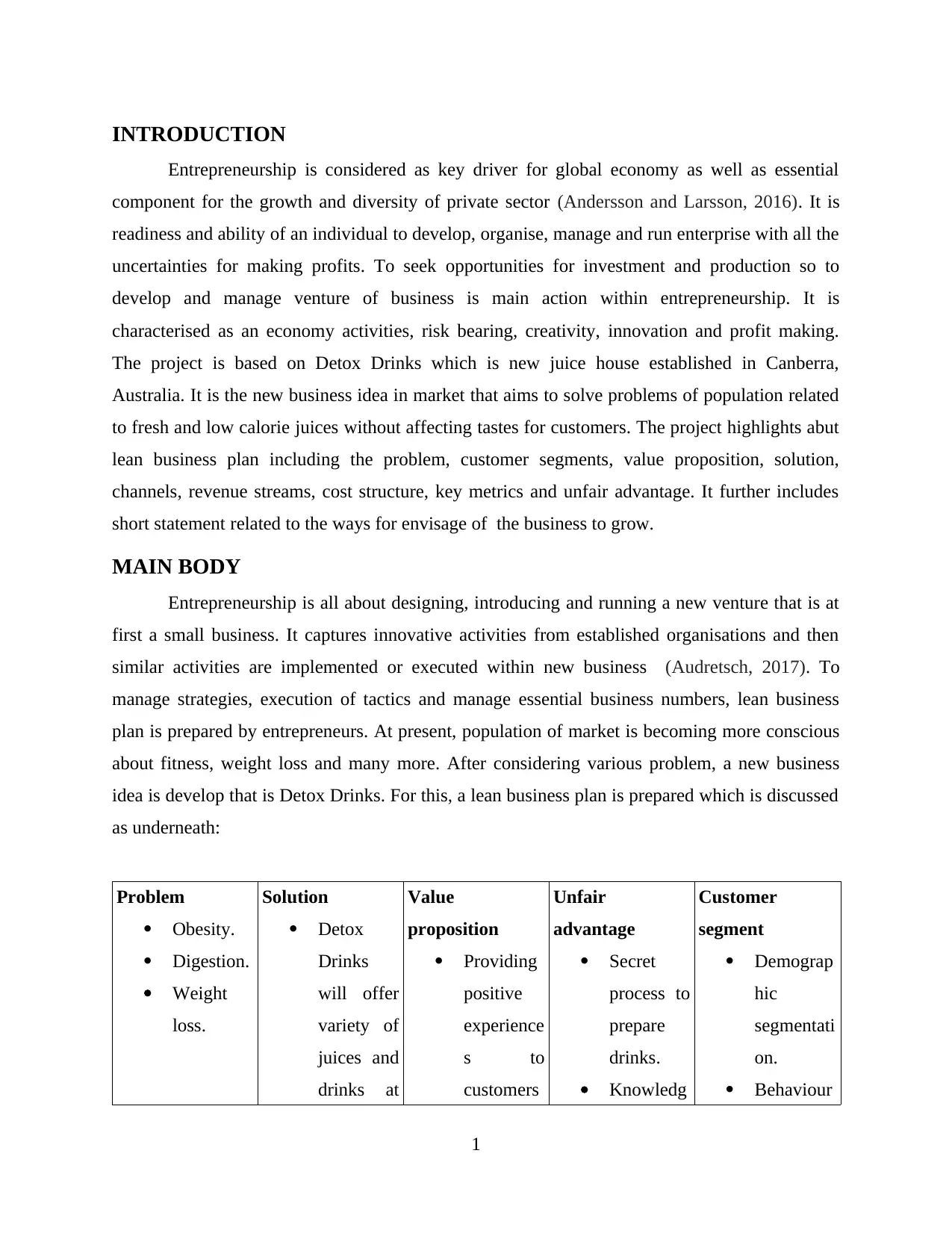
INTRODUCTION
Entrepreneurship is considered as key driver for global economy as well as essential
component for the growth and diversity of private sector (Andersson and Larsson, 2016). It is
readiness and ability of an individual to develop, organise, manage and run enterprise with all the
uncertainties for making profits. To seek opportunities for investment and production so to
develop and manage venture of business is main action within entrepreneurship. It is
characterised as an economy activities, risk bearing, creativity, innovation and profit making.
The project is based on Detox Drinks which is new juice house established in Canberra,
Australia. It is the new business idea in market that aims to solve problems of population related
to fresh and low calorie juices without affecting tastes for customers. The project highlights abut
lean business plan including the problem, customer segments, value proposition, solution,
channels, revenue streams, cost structure, key metrics and unfair advantage. It further includes
short statement related to the ways for envisage of the business to grow.
MAIN BODY
Entrepreneurship is all about designing, introducing and running a new venture that is at
first a small business. It captures innovative activities from established organisations and then
similar activities are implemented or executed within new business (Audretsch, 2017). To
manage strategies, execution of tactics and manage essential business numbers, lean business
plan is prepared by entrepreneurs. At present, population of market is becoming more conscious
about fitness, weight loss and many more. After considering various problem, a new business
idea is develop that is Detox Drinks. For this, a lean business plan is prepared which is discussed
as underneath:
Problem
Obesity.
Digestion.
Weight
loss.
Solution
Detox
Drinks
will offer
variety of
juices and
drinks at
Value
proposition
Providing
positive
experience
s to
customers
Unfair
advantage
Secret
process to
prepare
drinks.
Knowledg
Customer
segment
Demograp
hic
segmentati
on.
Behaviour
1
Entrepreneurship is considered as key driver for global economy as well as essential
component for the growth and diversity of private sector (Andersson and Larsson, 2016). It is
readiness and ability of an individual to develop, organise, manage and run enterprise with all the
uncertainties for making profits. To seek opportunities for investment and production so to
develop and manage venture of business is main action within entrepreneurship. It is
characterised as an economy activities, risk bearing, creativity, innovation and profit making.
The project is based on Detox Drinks which is new juice house established in Canberra,
Australia. It is the new business idea in market that aims to solve problems of population related
to fresh and low calorie juices without affecting tastes for customers. The project highlights abut
lean business plan including the problem, customer segments, value proposition, solution,
channels, revenue streams, cost structure, key metrics and unfair advantage. It further includes
short statement related to the ways for envisage of the business to grow.
MAIN BODY
Entrepreneurship is all about designing, introducing and running a new venture that is at
first a small business. It captures innovative activities from established organisations and then
similar activities are implemented or executed within new business (Audretsch, 2017). To
manage strategies, execution of tactics and manage essential business numbers, lean business
plan is prepared by entrepreneurs. At present, population of market is becoming more conscious
about fitness, weight loss and many more. After considering various problem, a new business
idea is develop that is Detox Drinks. For this, a lean business plan is prepared which is discussed
as underneath:
Problem
Obesity.
Digestion.
Weight
loss.
Solution
Detox
Drinks
will offer
variety of
juices and
drinks at
Value
proposition
Providing
positive
experience
s to
customers
Unfair
advantage
Secret
process to
prepare
drinks.
Knowledg
Customer
segment
Demograp
hic
segmentati
on.
Behaviour
1
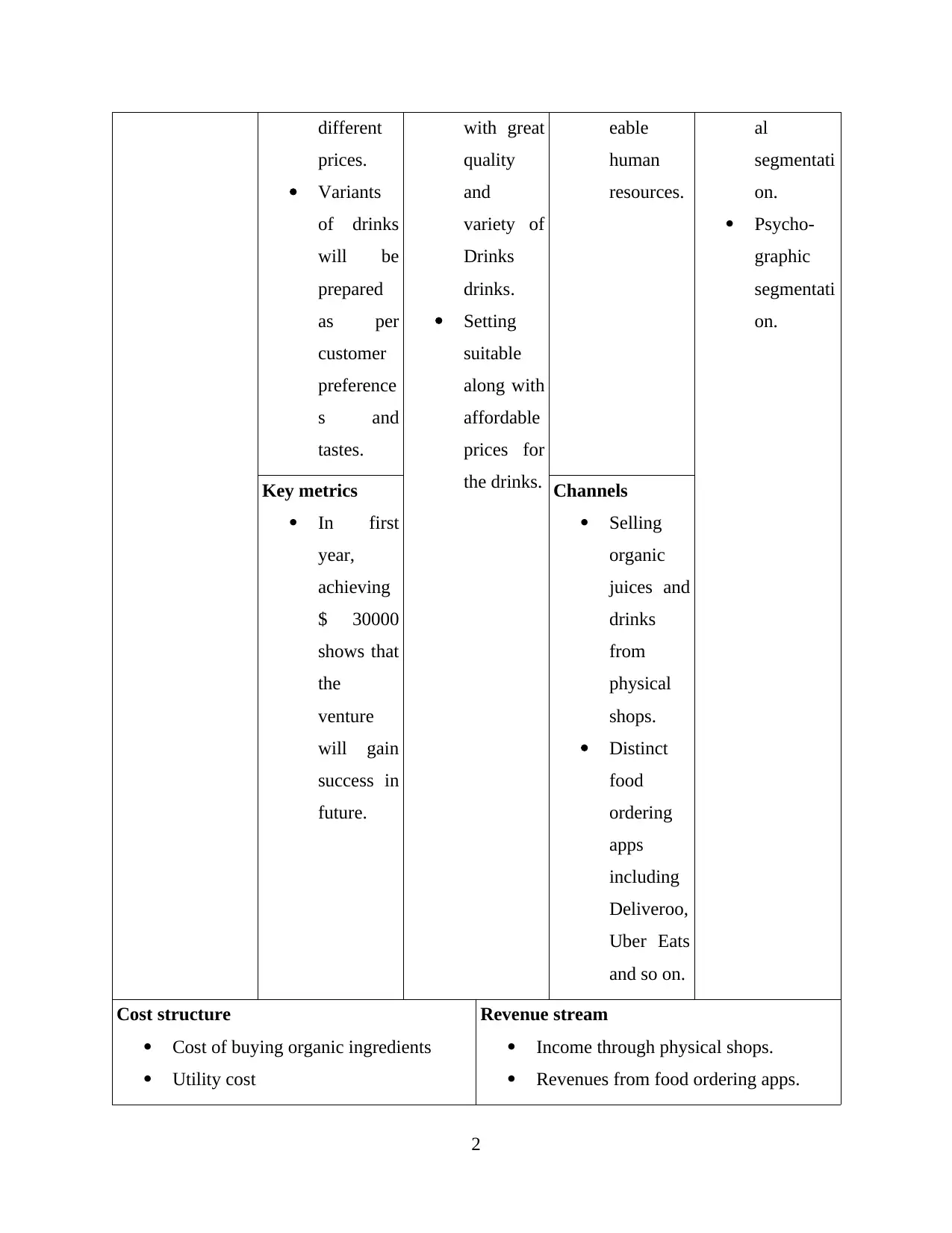
different
prices.
Variants
of drinks
will be
prepared
as per
customer
preference
s and
tastes.
with great
quality
and
variety of
Drinks
drinks.
Setting
suitable
along with
affordable
prices for
the drinks.
eable
human
resources.
al
segmentati
on.
Psycho-
graphic
segmentati
on.
Key metrics
In first
year,
achieving
$ 30000
shows that
the
venture
will gain
success in
future.
Channels
Selling
organic
juices and
drinks
from
physical
shops.
Distinct
food
ordering
apps
including
Deliveroo,
Uber Eats
and so on.
Cost structure
Cost of buying organic ingredients
Utility cost
Revenue stream
Income through physical shops.
Revenues from food ordering apps.
2
prices.
Variants
of drinks
will be
prepared
as per
customer
preference
s and
tastes.
with great
quality
and
variety of
Drinks
drinks.
Setting
suitable
along with
affordable
prices for
the drinks.
eable
human
resources.
al
segmentati
on.
Psycho-
graphic
segmentati
on.
Key metrics
In first
year,
achieving
$ 30000
shows that
the
venture
will gain
success in
future.
Channels
Selling
organic
juices and
drinks
from
physical
shops.
Distinct
food
ordering
apps
including
Deliveroo,
Uber Eats
and so on.
Cost structure
Cost of buying organic ingredients
Utility cost
Revenue stream
Income through physical shops.
Revenues from food ordering apps.
2
Secure Best Marks with AI Grader
Need help grading? Try our AI Grader for instant feedback on your assignments.

Rent for shops
Salaries to manpower
Taxation
Income from online promotions.
The problem
At present, population of Australia is facing problem related to obesity, weight, digestion
and complexions. Moreover, it is also analysed that people wants to reduce weight without
performing any exercise or workout and they also wants to improve the digestive system through
consuming some healthy drinks. The customers are now becoming more focused towards
boosting immune functions, improving moods and complexions also. The top problems that are
experienced by customers in resent era includes obesity, weight loss along with digestion
(Bosma and et.al., 2016). They also faces issues in enhancing energy levels and maintaining pH
level of the body. People of Australia are also suffering from various chronic illness that includes
high blood pressure, depression, anxiety and high cholesterol. To deal with all these, population
of the same city are expecting a product that can help them to solve these issues and live their
lives freely. By introducing a new idea that is Detox Drinks, all the problems will be solved as
the the new idea will offer various types of drinks whose intake or consumption will benefit
people to solve the problems related to obesity, weight loss and many more.
Customer segments
Customer segmentation is said as procedure for dividing customers into various types of
groups on the basis of some common characteristics in order to market each group in appropriate
along with effective manner (Poggesi, Mari and De Vita, 2016). Potential customers are defined
as the individuals who purchases products from entity. Following are the basis on which entire
target market is segmented for the new idea that is Detox Drinks:
Demographic segmentation: Demographics is described as statistical description of
people that are characterised in context to gender, family size, gender, level of education and
income (Cacciotti and et.al., 2016). The rationale behind such segmentation is that it can assist
firms to target customers in accurate manner and searching out best ways for serve the needs of
the customers. Customers that are between the age group of 17 years to 55 years that belongs to
income class such as high income and middle income level are segmented as potential
3
Salaries to manpower
Taxation
Income from online promotions.
The problem
At present, population of Australia is facing problem related to obesity, weight, digestion
and complexions. Moreover, it is also analysed that people wants to reduce weight without
performing any exercise or workout and they also wants to improve the digestive system through
consuming some healthy drinks. The customers are now becoming more focused towards
boosting immune functions, improving moods and complexions also. The top problems that are
experienced by customers in resent era includes obesity, weight loss along with digestion
(Bosma and et.al., 2016). They also faces issues in enhancing energy levels and maintaining pH
level of the body. People of Australia are also suffering from various chronic illness that includes
high blood pressure, depression, anxiety and high cholesterol. To deal with all these, population
of the same city are expecting a product that can help them to solve these issues and live their
lives freely. By introducing a new idea that is Detox Drinks, all the problems will be solved as
the the new idea will offer various types of drinks whose intake or consumption will benefit
people to solve the problems related to obesity, weight loss and many more.
Customer segments
Customer segmentation is said as procedure for dividing customers into various types of
groups on the basis of some common characteristics in order to market each group in appropriate
along with effective manner (Poggesi, Mari and De Vita, 2016). Potential customers are defined
as the individuals who purchases products from entity. Following are the basis on which entire
target market is segmented for the new idea that is Detox Drinks:
Demographic segmentation: Demographics is described as statistical description of
people that are characterised in context to gender, family size, gender, level of education and
income (Cacciotti and et.al., 2016). The rationale behind such segmentation is that it can assist
firms to target customers in accurate manner and searching out best ways for serve the needs of
the customers. Customers that are between the age group of 17 years to 55 years that belongs to
income class such as high income and middle income level are segmented as potential
3
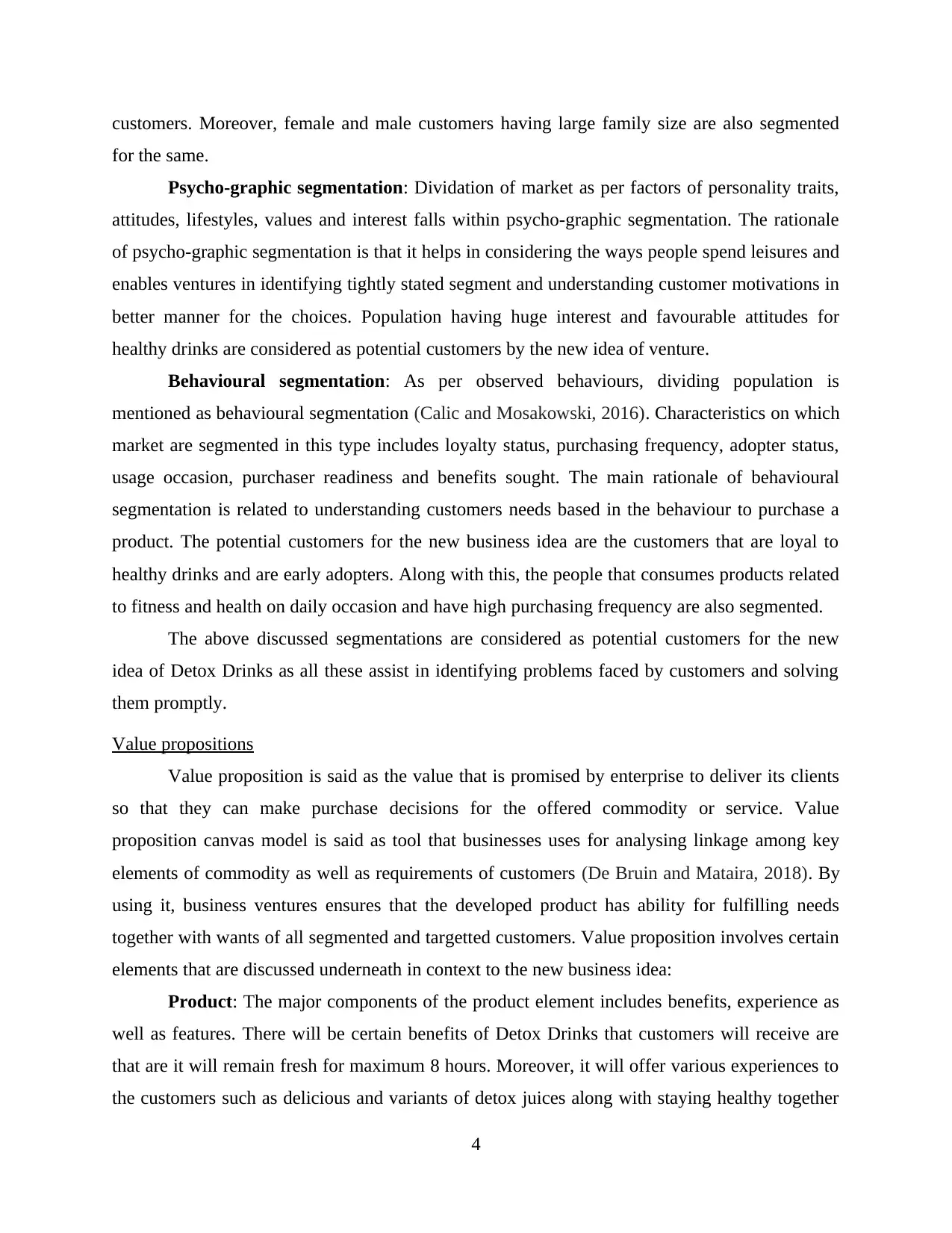
customers. Moreover, female and male customers having large family size are also segmented
for the same.
Psycho-graphic segmentation: Dividation of market as per factors of personality traits,
attitudes, lifestyles, values and interest falls within psycho-graphic segmentation. The rationale
of psycho-graphic segmentation is that it helps in considering the ways people spend leisures and
enables ventures in identifying tightly stated segment and understanding customer motivations in
better manner for the choices. Population having huge interest and favourable attitudes for
healthy drinks are considered as potential customers by the new idea of venture.
Behavioural segmentation: As per observed behaviours, dividing population is
mentioned as behavioural segmentation (Calic and Mosakowski, 2016). Characteristics on which
market are segmented in this type includes loyalty status, purchasing frequency, adopter status,
usage occasion, purchaser readiness and benefits sought. The main rationale of behavioural
segmentation is related to understanding customers needs based in the behaviour to purchase a
product. The potential customers for the new business idea are the customers that are loyal to
healthy drinks and are early adopters. Along with this, the people that consumes products related
to fitness and health on daily occasion and have high purchasing frequency are also segmented.
The above discussed segmentations are considered as potential customers for the new
idea of Detox Drinks as all these assist in identifying problems faced by customers and solving
them promptly.
Value propositions
Value proposition is said as the value that is promised by enterprise to deliver its clients
so that they can make purchase decisions for the offered commodity or service. Value
proposition canvas model is said as tool that businesses uses for analysing linkage among key
elements of commodity as well as requirements of customers (De Bruin and Mataira, 2018). By
using it, business ventures ensures that the developed product has ability for fulfilling needs
together with wants of all segmented and targetted customers. Value proposition involves certain
elements that are discussed underneath in context to the new business idea:
Product: The major components of the product element includes benefits, experience as
well as features. There will be certain benefits of Detox Drinks that customers will receive are
that are it will remain fresh for maximum 8 hours. Moreover, it will offer various experiences to
the customers such as delicious and variants of detox juices along with staying healthy together
4
for the same.
Psycho-graphic segmentation: Dividation of market as per factors of personality traits,
attitudes, lifestyles, values and interest falls within psycho-graphic segmentation. The rationale
of psycho-graphic segmentation is that it helps in considering the ways people spend leisures and
enables ventures in identifying tightly stated segment and understanding customer motivations in
better manner for the choices. Population having huge interest and favourable attitudes for
healthy drinks are considered as potential customers by the new idea of venture.
Behavioural segmentation: As per observed behaviours, dividing population is
mentioned as behavioural segmentation (Calic and Mosakowski, 2016). Characteristics on which
market are segmented in this type includes loyalty status, purchasing frequency, adopter status,
usage occasion, purchaser readiness and benefits sought. The main rationale of behavioural
segmentation is related to understanding customers needs based in the behaviour to purchase a
product. The potential customers for the new business idea are the customers that are loyal to
healthy drinks and are early adopters. Along with this, the people that consumes products related
to fitness and health on daily occasion and have high purchasing frequency are also segmented.
The above discussed segmentations are considered as potential customers for the new
idea of Detox Drinks as all these assist in identifying problems faced by customers and solving
them promptly.
Value propositions
Value proposition is said as the value that is promised by enterprise to deliver its clients
so that they can make purchase decisions for the offered commodity or service. Value
proposition canvas model is said as tool that businesses uses for analysing linkage among key
elements of commodity as well as requirements of customers (De Bruin and Mataira, 2018). By
using it, business ventures ensures that the developed product has ability for fulfilling needs
together with wants of all segmented and targetted customers. Value proposition involves certain
elements that are discussed underneath in context to the new business idea:
Product: The major components of the product element includes benefits, experience as
well as features. There will be certain benefits of Detox Drinks that customers will receive are
that are it will remain fresh for maximum 8 hours. Moreover, it will offer various experiences to
the customers such as delicious and variants of detox juices along with staying healthy together
4
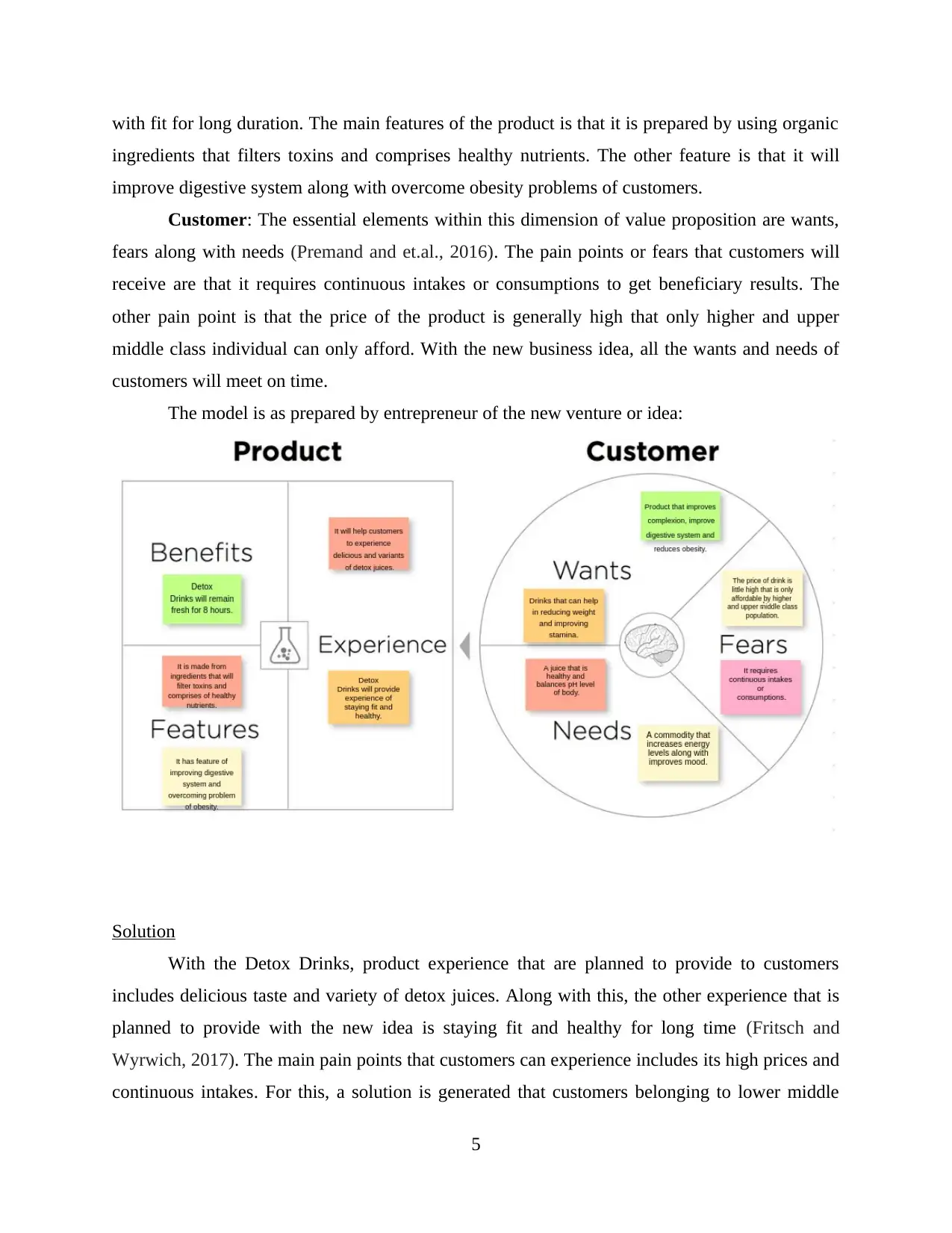
with fit for long duration. The main features of the product is that it is prepared by using organic
ingredients that filters toxins and comprises healthy nutrients. The other feature is that it will
improve digestive system along with overcome obesity problems of customers.
Customer: The essential elements within this dimension of value proposition are wants,
fears along with needs (Premand and et.al., 2016). The pain points or fears that customers will
receive are that it requires continuous intakes or consumptions to get beneficiary results. The
other pain point is that the price of the product is generally high that only higher and upper
middle class individual can only afford. With the new business idea, all the wants and needs of
customers will meet on time.
The model is as prepared by entrepreneur of the new venture or idea:
Solution
With the Detox Drinks, product experience that are planned to provide to customers
includes delicious taste and variety of detox juices. Along with this, the other experience that is
planned to provide with the new idea is staying fit and healthy for long time (Fritsch and
Wyrwich, 2017). The main pain points that customers can experience includes its high prices and
continuous intakes. For this, a solution is generated that customers belonging to lower middle
5
ingredients that filters toxins and comprises healthy nutrients. The other feature is that it will
improve digestive system along with overcome obesity problems of customers.
Customer: The essential elements within this dimension of value proposition are wants,
fears along with needs (Premand and et.al., 2016). The pain points or fears that customers will
receive are that it requires continuous intakes or consumptions to get beneficiary results. The
other pain point is that the price of the product is generally high that only higher and upper
middle class individual can only afford. With the new business idea, all the wants and needs of
customers will meet on time.
The model is as prepared by entrepreneur of the new venture or idea:
Solution
With the Detox Drinks, product experience that are planned to provide to customers
includes delicious taste and variety of detox juices. Along with this, the other experience that is
planned to provide with the new idea is staying fit and healthy for long time (Fritsch and
Wyrwich, 2017). The main pain points that customers can experience includes its high prices and
continuous intakes. For this, a solution is generated that customers belonging to lower middle
5
Paraphrase This Document
Need a fresh take? Get an instant paraphrase of this document with our AI Paraphraser

and lower class can take it in various quantities as per their affordability that will help them to
experience the results of the products in terms of reduction in obesity, weight loss and improved
digestion system. With this, customers will be able to analyse reduction in their pain points and
gaining successful product experiences. Moreover, to solve the problems, Detox Drinks will
offer variety of organic drinks at different prices. Along with this, variants of drinks will be
prepared as per customer preferences and tastes.
Channels
Channels are the distribution system with the help of which companies are able to
acquire, sell along with retain customers for long time (Lafontaine and Shaw, 2016). Various
channels are used by an individual entity as they assist in the ways through which all the
products are offered to customers as per their choices and interests. Detox Drinks will majorly
emphasis on its physical stores in which the variety of drinks will be offered to customers with
different packages. For reaching maximum customers, the venture will also tie up with Uber Eats
and Deliveroo that will help in increasing sales volume as well as delivering detox drinks and
juices at door step of clients. Moreover, the entrepreneur have planned to market the new
concept of idea through using online media or platforms including Instagram and Facebook.
With all these, the new business venture will be able to increase awareness among large
customers for the new idea and selling products and retaining them with the venture.
Revenue streams
Revenue streams are revenue sources of an organisation. For executing the business idea
systematically it is essential for entrepreneurs to generate revenues in order to acquire funds for
carry forwarding various operations (Lee, Hallak and Sardeshmukh, 2016). The main streams
from which revenues for Detox Drinks will come includes selling its juices and drinks are sales
from physical stores, sales through applications including Uber Eats, Deliveroo and many more
and revenues from advertisements. Furthermore, customers will pay through various modes that
includes cash on delivery, using credit cards and mobile payments. With these mechanisms,
customers will be able to pay the money for the drinks and juices that they will purchase from
the channels. To make money, entrepreneurs of Detox Drinks will take help of family members
and venture capitalists so that they can get the required investment amount and financial
resources needed to manage day to day operations successfully. By selling variants of drinks and
juices the expected profits that the new idea will make is around $ 650000 till February, 2024.
6
experience the results of the products in terms of reduction in obesity, weight loss and improved
digestion system. With this, customers will be able to analyse reduction in their pain points and
gaining successful product experiences. Moreover, to solve the problems, Detox Drinks will
offer variety of organic drinks at different prices. Along with this, variants of drinks will be
prepared as per customer preferences and tastes.
Channels
Channels are the distribution system with the help of which companies are able to
acquire, sell along with retain customers for long time (Lafontaine and Shaw, 2016). Various
channels are used by an individual entity as they assist in the ways through which all the
products are offered to customers as per their choices and interests. Detox Drinks will majorly
emphasis on its physical stores in which the variety of drinks will be offered to customers with
different packages. For reaching maximum customers, the venture will also tie up with Uber Eats
and Deliveroo that will help in increasing sales volume as well as delivering detox drinks and
juices at door step of clients. Moreover, the entrepreneur have planned to market the new
concept of idea through using online media or platforms including Instagram and Facebook.
With all these, the new business venture will be able to increase awareness among large
customers for the new idea and selling products and retaining them with the venture.
Revenue streams
Revenue streams are revenue sources of an organisation. For executing the business idea
systematically it is essential for entrepreneurs to generate revenues in order to acquire funds for
carry forwarding various operations (Lee, Hallak and Sardeshmukh, 2016). The main streams
from which revenues for Detox Drinks will come includes selling its juices and drinks are sales
from physical stores, sales through applications including Uber Eats, Deliveroo and many more
and revenues from advertisements. Furthermore, customers will pay through various modes that
includes cash on delivery, using credit cards and mobile payments. With these mechanisms,
customers will be able to pay the money for the drinks and juices that they will purchase from
the channels. To make money, entrepreneurs of Detox Drinks will take help of family members
and venture capitalists so that they can get the required investment amount and financial
resources needed to manage day to day operations successfully. By selling variants of drinks and
juices the expected profits that the new idea will make is around $ 650000 till February, 2024.
6
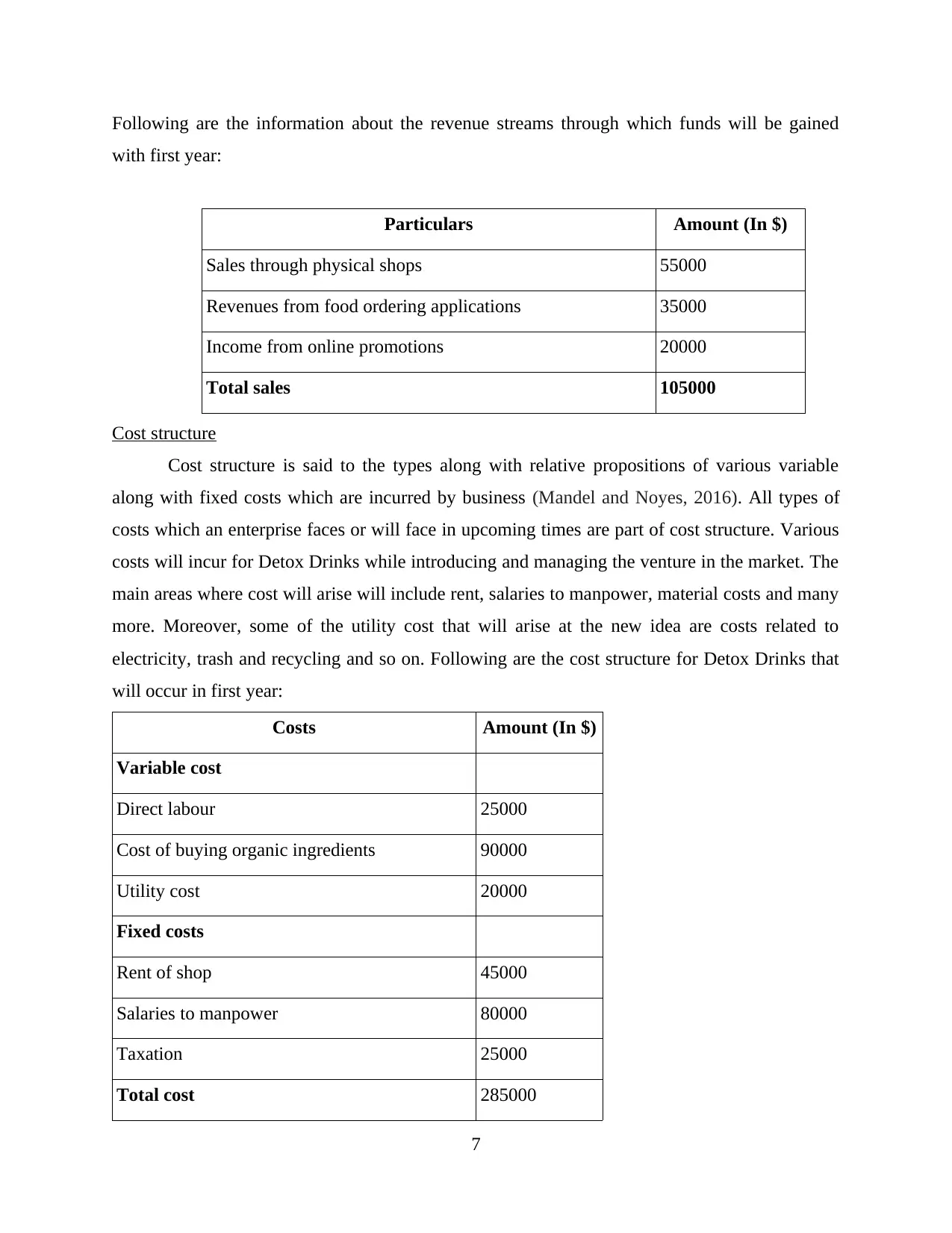
Following are the information about the revenue streams through which funds will be gained
with first year:
Particulars Amount (In $)
Sales through physical shops 55000
Revenues from food ordering applications 35000
Income from online promotions 20000
Total sales 105000
Cost structure
Cost structure is said to the types along with relative propositions of various variable
along with fixed costs which are incurred by business (Mandel and Noyes, 2016). All types of
costs which an enterprise faces or will face in upcoming times are part of cost structure. Various
costs will incur for Detox Drinks while introducing and managing the venture in the market. The
main areas where cost will arise will include rent, salaries to manpower, material costs and many
more. Moreover, some of the utility cost that will arise at the new idea are costs related to
electricity, trash and recycling and so on. Following are the cost structure for Detox Drinks that
will occur in first year:
Costs Amount (In $)
Variable cost
Direct labour 25000
Cost of buying organic ingredients 90000
Utility cost 20000
Fixed costs
Rent of shop 45000
Salaries to manpower 80000
Taxation 25000
Total cost 285000
7
with first year:
Particulars Amount (In $)
Sales through physical shops 55000
Revenues from food ordering applications 35000
Income from online promotions 20000
Total sales 105000
Cost structure
Cost structure is said to the types along with relative propositions of various variable
along with fixed costs which are incurred by business (Mandel and Noyes, 2016). All types of
costs which an enterprise faces or will face in upcoming times are part of cost structure. Various
costs will incur for Detox Drinks while introducing and managing the venture in the market. The
main areas where cost will arise will include rent, salaries to manpower, material costs and many
more. Moreover, some of the utility cost that will arise at the new idea are costs related to
electricity, trash and recycling and so on. Following are the cost structure for Detox Drinks that
will occur in first year:
Costs Amount (In $)
Variable cost
Direct labour 25000
Cost of buying organic ingredients 90000
Utility cost 20000
Fixed costs
Rent of shop 45000
Salaries to manpower 80000
Taxation 25000
Total cost 285000
7

Key metrics
Key metrics are statists whose values gives measures for overall performance of company
(Siqueira, Webb and Bruton, 2016). The entrepreneur of Detox Drinks have determined that in
first year, it will be able to make revenues of 315000. Further, calculations of BEP for the new
idea are the followings:
BEP= Fixed cost / PV ratio
= 150000 / 57.14%
= 262513.1 (BEP sales)
PV ratio = Contribution / sales* 100
= 180000 / 315000 * 100
= 57.14%
Contribution= Sales – variable costs
= 315000- 135000
= 180000
Budget for first two years:
Particulars Year 1 Year 2 Year 3
Opening balance - 30000 80000
Receipts
Revenues 315000 350000 400000
Total A 315000 380000 480000
Payments
Direct labour 25000 28000 35000
Cost of buying organic ingredients 90000 100000 120000
Utility cost 20000 22000 25000
Rent of shop 45000 45000 45000
Salaries to staff 80000 80000 80000
8
Key metrics are statists whose values gives measures for overall performance of company
(Siqueira, Webb and Bruton, 2016). The entrepreneur of Detox Drinks have determined that in
first year, it will be able to make revenues of 315000. Further, calculations of BEP for the new
idea are the followings:
BEP= Fixed cost / PV ratio
= 150000 / 57.14%
= 262513.1 (BEP sales)
PV ratio = Contribution / sales* 100
= 180000 / 315000 * 100
= 57.14%
Contribution= Sales – variable costs
= 315000- 135000
= 180000
Budget for first two years:
Particulars Year 1 Year 2 Year 3
Opening balance - 30000 80000
Receipts
Revenues 315000 350000 400000
Total A 315000 380000 480000
Payments
Direct labour 25000 28000 35000
Cost of buying organic ingredients 90000 100000 120000
Utility cost 20000 22000 25000
Rent of shop 45000 45000 45000
Salaries to staff 80000 80000 80000
8
Secure Best Marks with AI Grader
Need help grading? Try our AI Grader for instant feedback on your assignments.

Taxation 25000 25000 25000
Total B285000 285000 300000 330000
Closing balance (Total A - B) 30000 80000 150000
Unfair advantage
Detox Drinks is an unique business idea that have various imitable elements such as
variants of organic drinks and a secret procedure to prepare the drinks which other juice
companies cannot bought. Moreover, the venture has human resources that have knowledge
about preparing healthy, delicious and variety of juices that benefits customers to change their
mood and many other aspects. All the resources and knowledge belongs exclusively to the
venture as it has hired its manpower to prepare drinks after considering problems of market.
Growth
There are various ways in which companies plan to manage the growth of enterprise
(Pato and Teixeira, 2016). In case with the new venture that is Detox Drinks, the entrepreneur
plans to manage the entrepreneurial growth by keeping customers happy, working with right
team, focusing on financial implications and subtracting the irrelevant things while adding new
productive ones. Moreover, the company is planning to expand in market of Canberra, Australia
as soon as possible. By considering the expected financial budget, it can be said that the idea will
attain growth in the selected market. Considering the venture situations in context to profits, it
can be said that at development stage of business growth, the entrepreneur of the venture will
plan to harvest the business so that it can gain various opportunities for further expansion.
CONCLUSION
From above discussion it can be said that entrepreneurship is pursuits of diverse
opportunities that are beyond controlling resources. It is an act that creates businesses through
building as well as scaling it with objective to generate profits. Lean business plan is generally
used to for managing strategies, implementations together with important business numbers. It is
only used for internal purposes and majorly by the entrepreneurs who plans to introduce a new
venture. The venture or business idea is the solution that are faced by populations of market. It
covers various elements such as problem, target customer segment, value proposition and so on.
9
Total B285000 285000 300000 330000
Closing balance (Total A - B) 30000 80000 150000
Unfair advantage
Detox Drinks is an unique business idea that have various imitable elements such as
variants of organic drinks and a secret procedure to prepare the drinks which other juice
companies cannot bought. Moreover, the venture has human resources that have knowledge
about preparing healthy, delicious and variety of juices that benefits customers to change their
mood and many other aspects. All the resources and knowledge belongs exclusively to the
venture as it has hired its manpower to prepare drinks after considering problems of market.
Growth
There are various ways in which companies plan to manage the growth of enterprise
(Pato and Teixeira, 2016). In case with the new venture that is Detox Drinks, the entrepreneur
plans to manage the entrepreneurial growth by keeping customers happy, working with right
team, focusing on financial implications and subtracting the irrelevant things while adding new
productive ones. Moreover, the company is planning to expand in market of Canberra, Australia
as soon as possible. By considering the expected financial budget, it can be said that the idea will
attain growth in the selected market. Considering the venture situations in context to profits, it
can be said that at development stage of business growth, the entrepreneur of the venture will
plan to harvest the business so that it can gain various opportunities for further expansion.
CONCLUSION
From above discussion it can be said that entrepreneurship is pursuits of diverse
opportunities that are beyond controlling resources. It is an act that creates businesses through
building as well as scaling it with objective to generate profits. Lean business plan is generally
used to for managing strategies, implementations together with important business numbers. It is
only used for internal purposes and majorly by the entrepreneurs who plans to introduce a new
venture. The venture or business idea is the solution that are faced by populations of market. It
covers various elements such as problem, target customer segment, value proposition and so on.
9
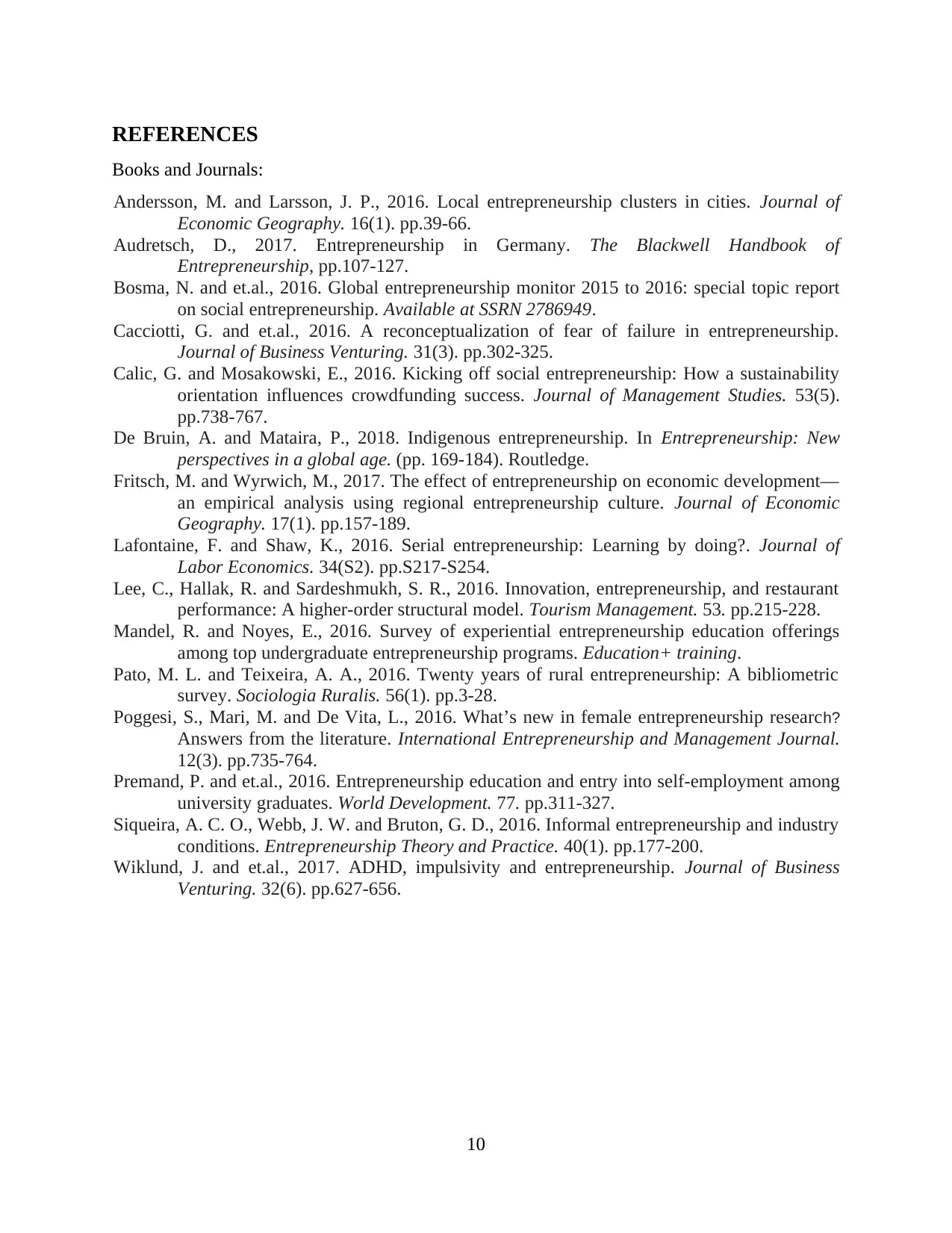
REFERENCES
Books and Journals:
Andersson, M. and Larsson, J. P., 2016. Local entrepreneurship clusters in cities. Journal of
Economic Geography. 16(1). pp.39-66.
Audretsch, D., 2017. Entrepreneurship in Germany. The Blackwell Handbook of
Entrepreneurship, pp.107-127.
Bosma, N. and et.al., 2016. Global entrepreneurship monitor 2015 to 2016: special topic report
on social entrepreneurship. Available at SSRN 2786949.
Cacciotti, G. and et.al., 2016. A reconceptualization of fear of failure in entrepreneurship.
Journal of Business Venturing. 31(3). pp.302-325.
Calic, G. and Mosakowski, E., 2016. Kicking off social entrepreneurship: How a sustainability
orientation influences crowdfunding success. Journal of Management Studies. 53(5).
pp.738-767.
De Bruin, A. and Mataira, P., 2018. Indigenous entrepreneurship. In Entrepreneurship: New
perspectives in a global age. (pp. 169-184). Routledge.
Fritsch, M. and Wyrwich, M., 2017. The effect of entrepreneurship on economic development—
an empirical analysis using regional entrepreneurship culture. Journal of Economic
Geography. 17(1). pp.157-189.
Lafontaine, F. and Shaw, K., 2016. Serial entrepreneurship: Learning by doing?. Journal of
Labor Economics. 34(S2). pp.S217-S254.
Lee, C., Hallak, R. and Sardeshmukh, S. R., 2016. Innovation, entrepreneurship, and restaurant
performance: A higher-order structural model. Tourism Management. 53. pp.215-228.
Mandel, R. and Noyes, E., 2016. Survey of experiential entrepreneurship education offerings
among top undergraduate entrepreneurship programs. Education+ training.
Pato, M. L. and Teixeira, A. A., 2016. Twenty years of rural entrepreneurship: A bibliometric
survey. Sociologia Ruralis. 56(1). pp.3-28.
Poggesi, S., Mari, M. and De Vita, L., 2016. What’s new in female entrepreneurship research?
Answers from the literature. International Entrepreneurship and Management Journal.
12(3). pp.735-764.
Premand, P. and et.al., 2016. Entrepreneurship education and entry into self-employment among
university graduates. World Development. 77. pp.311-327.
Siqueira, A. C. O., Webb, J. W. and Bruton, G. D., 2016. Informal entrepreneurship and industry
conditions. Entrepreneurship Theory and Practice. 40(1). pp.177-200.
Wiklund, J. and et.al., 2017. ADHD, impulsivity and entrepreneurship. Journal of Business
Venturing. 32(6). pp.627-656.
10
Books and Journals:
Andersson, M. and Larsson, J. P., 2016. Local entrepreneurship clusters in cities. Journal of
Economic Geography. 16(1). pp.39-66.
Audretsch, D., 2017. Entrepreneurship in Germany. The Blackwell Handbook of
Entrepreneurship, pp.107-127.
Bosma, N. and et.al., 2016. Global entrepreneurship monitor 2015 to 2016: special topic report
on social entrepreneurship. Available at SSRN 2786949.
Cacciotti, G. and et.al., 2016. A reconceptualization of fear of failure in entrepreneurship.
Journal of Business Venturing. 31(3). pp.302-325.
Calic, G. and Mosakowski, E., 2016. Kicking off social entrepreneurship: How a sustainability
orientation influences crowdfunding success. Journal of Management Studies. 53(5).
pp.738-767.
De Bruin, A. and Mataira, P., 2018. Indigenous entrepreneurship. In Entrepreneurship: New
perspectives in a global age. (pp. 169-184). Routledge.
Fritsch, M. and Wyrwich, M., 2017. The effect of entrepreneurship on economic development—
an empirical analysis using regional entrepreneurship culture. Journal of Economic
Geography. 17(1). pp.157-189.
Lafontaine, F. and Shaw, K., 2016. Serial entrepreneurship: Learning by doing?. Journal of
Labor Economics. 34(S2). pp.S217-S254.
Lee, C., Hallak, R. and Sardeshmukh, S. R., 2016. Innovation, entrepreneurship, and restaurant
performance: A higher-order structural model. Tourism Management. 53. pp.215-228.
Mandel, R. and Noyes, E., 2016. Survey of experiential entrepreneurship education offerings
among top undergraduate entrepreneurship programs. Education+ training.
Pato, M. L. and Teixeira, A. A., 2016. Twenty years of rural entrepreneurship: A bibliometric
survey. Sociologia Ruralis. 56(1). pp.3-28.
Poggesi, S., Mari, M. and De Vita, L., 2016. What’s new in female entrepreneurship research?
Answers from the literature. International Entrepreneurship and Management Journal.
12(3). pp.735-764.
Premand, P. and et.al., 2016. Entrepreneurship education and entry into self-employment among
university graduates. World Development. 77. pp.311-327.
Siqueira, A. C. O., Webb, J. W. and Bruton, G. D., 2016. Informal entrepreneurship and industry
conditions. Entrepreneurship Theory and Practice. 40(1). pp.177-200.
Wiklund, J. and et.al., 2017. ADHD, impulsivity and entrepreneurship. Journal of Business
Venturing. 32(6). pp.627-656.
10
1 out of 12
Related Documents
Your All-in-One AI-Powered Toolkit for Academic Success.
+13062052269
info@desklib.com
Available 24*7 on WhatsApp / Email
![[object Object]](/_next/static/media/star-bottom.7253800d.svg)
Unlock your academic potential
© 2024 | Zucol Services PVT LTD | All rights reserved.





